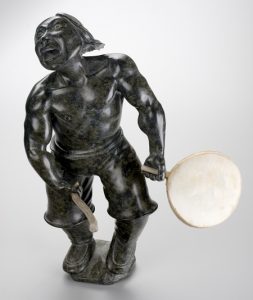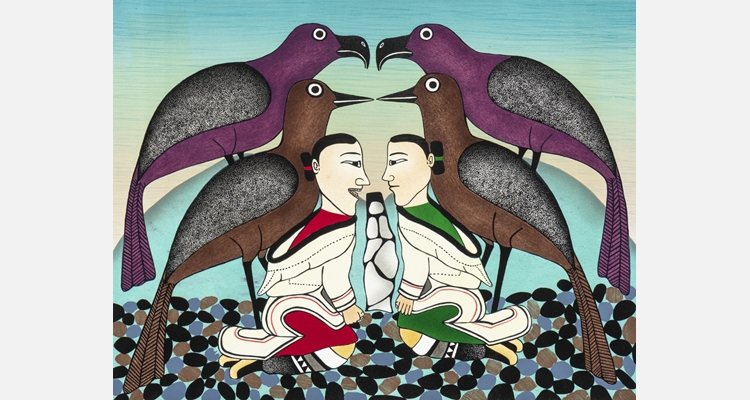Montreal Museum of Fine Arts presents
ᑐᓴᕐᓂᑐᑦ TUSARNITUT!
Music Born of the Cold
Through March 12, 2023, the Montreal Museum of Fine Arts is inviting the public to discover the breadth and diversity of Inuit musical expression in the visual and performing arts of the Arctic in ᑐᓴᕐᓂᑐᑦ TUSARNITUT! Music Born of the Cold. Bringing together artworks from the 1950s to the present, the exhibition presents, from a circumpolar perspective, a transhistorical exploration of the fundamental role music plays in Inuit life, while providing a rare opportunity to appreciate differences in style and content among artists and regions.
The practice of song and dance among the Inuit is inextricably linked to their environment, culture and lands. ᑐᓴᕐᓂᑐᑦ TUSARNITUT! (which translates literally as “pleasing sounds to the ear”) offers a glimpse into these art forms that are common throughout Inuit Nunaat (lands inhabited by the Inuit), an area that covers the circumpolar region, spanning Chukotka, Siberia, to Alaska, Canada and Greenland, and that is home to a population of more than 180,000. The exhibition proposes a discovery of these musical traditions and aims to show how they continue to shape Inuit culture today.

Davie Atchealak (1947-2006), Untitled (Drum
Beater), about 1996. Collection of Lois and
Daniel Miller.
Photo MMFA, Christine Guest
ᑐᓴᕐᓂᑐᑦ TUSARNITUT! presents over one hundred sculptures, prints drawings and installations themed around music by such renowned Inuit artists as Karoo Ashevak, Kenojuak Ashevak, Pitseolak Ashoona, Mattiusi Iyaituk, David Ruben Piqtoukun, Annie Pootoogook, Kananginaq Pootoogook, Jessie Oonark and Niap (Nancy Saunders). These works are drawn from the collections of the MMFA and the Avataq Cultural Institute as well as from local and international lenders. They are complemented by objects, artifacts, photographs, archival footage and music clips that allow the public to take in and appreciate the rich Inuit musical traditions simultaneously through sight and sound.
Two prominent musical genres are the focus of the presentation: qilaujjaniq (drum dancing) and katajjaniq (throat singing). ᑐᓴᕐᓂᑐᑦ TUSARNITUT! also highlights the cultural transformations and musical exchanges that occurred in the late 19th and early 20th centuries, a period when widespread colonial contact in the Arctic regions fostered Inuit adaptation of new instruments and musical ideas. These historical shifts provide a basis for highlighting the evolving appearance and function of contemporary Inuit art – forms of expression dedicated to the flourishing of Arctic Indigenous languages, art and musical practices and integral to processes of Indigenous self-determination today.
“We are very proud to present this groundbreaking exhibition celebrating the ingenuity of Inuit art and musical culture. Combining art history, musicology, and anthropology TUSARNITUT! puts Inuit voices forward, shedding new light on the importance of music to Inuit culture and highlighting the resurgence of Inuit musical traditions,” says Mary-Dailey Desmarais, Chief Curator of the MMFA.
“Throughout the exhibition, we have included rare archival films and music selections so that you can hear and see this rich musical tradition in action. It is our hope that the works and musical performances presented will enable deeper reflections on the perseverance and ingenuity of Inuit culture and people as they confronted the forces of colonization, which sought to suppress their music and voices,” adds Lisa Qiluqqi Koperqualuk, Curator and Mediator of Inuit Art at MMFA.
“TUSARNITUT! in part presents works from a collection I built up over the years in the course of studying Inuit music. These artworks, which reference the musical output of Inuit peoples, have been integrated into an exhibition in order to introduce the public at large to the remarkable diversity of this culture,” explains Jean- Jacques Nattiez, guest curator of the exhibition, ethnomusicologist and Professor Emeritus at the Université de Montréal.
For tickets visit: www.mbam.qc.ca


